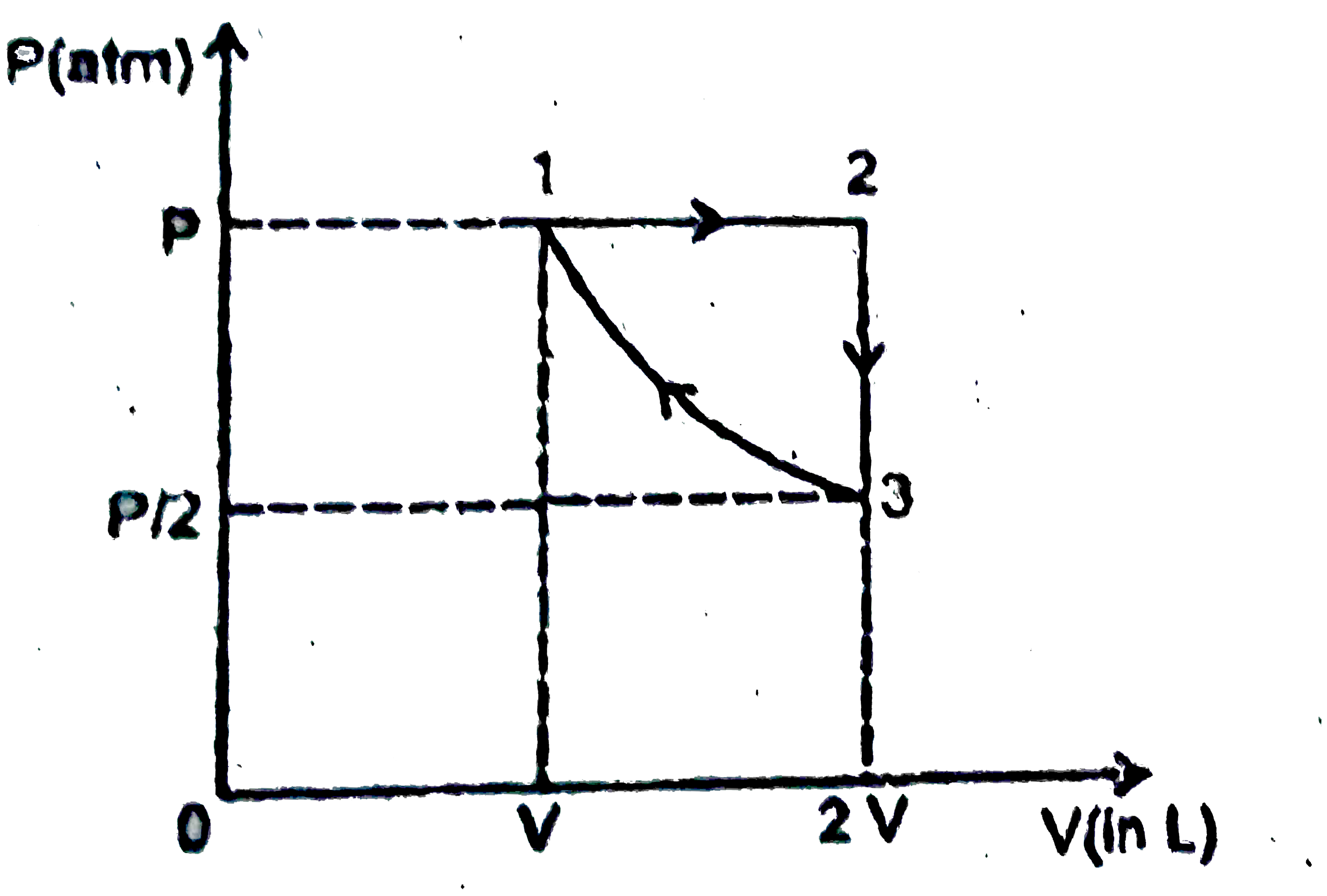Two moles of a perfect gas undergo the following process: (a) A reversible isobaric expansion from (1.0 atm, 20.0 litre) to (1.0 atm,40.0litre). (b) A reversible isochoric change of state from (1.0 atm, 40.0 litre) to (1.0 atm, 40.0 litre). (b) A reversible isochoric change of state from (1.0 atm, 40.0 litre) to (0.5 atm, 40.0 litre). (c) A reversible isothermal compression from (0.5atm, 40.0 litre) to (1.0 atm, 20.0 litre). (i) Sketch with labels each of the process on the same P−V diagram. (ii) Calculate the total work (W) and the total heat change (q) involved in the above process. (iii) What will be the value of ΔU,ΔH and ΔS for the overall process?
(i) 
T=PVnR=1×202×0.082=121.95 K
(ii) Total work (W) =W1+W2+W3
=−1×20+2.303×2×0.082×121.95log2
=−20+13.86=−6.13 L atm.
Since the system has returned to its initial state, i.e. the process is cyclic. So, ΔU=0
ΔU=q+W=0
q=−W=6.13Latm=620.7 J
In a cyclic process heat absorbed is completely converted into work.
Entropy is a state function and since the system has returned to its initial state so ΔS=0. Similarly, ΔH=0 and ΔU=0 for the same reason, i.e. U and H are also state functions having definite values in a given state of a system.
Topper's Solved these Questions
- THERMODYNAMICS AND THERMOCHEMISTRY BOOK - FIITJEECHAPTER - THERMODYNAMICS AND THERMOCHEMISTRY EXERCISE - SOLVED PROBLEM (SUBJECTIVE)
13 Videos
- THERMODYNAMICS AND THERMOCHEMISTRY BOOK - FIITJEECHAPTER - THERMODYNAMICS AND THERMOCHEMISTRY EXERCISE - SOLVED PROBLEMS (OBJECTIVE)
28 Videos
- TEST PAPERSBOOK - FIITJEECHAPTER - TEST PAPERSEXERCISE - CHEMISTRY
747 Videos
- TRANSITION ELEMENTS & COORDINATION COMPOUNDSBOOK - FIITJEECHAPTER - TRANSITION ELEMENTS & COORDINATION COMPOUNDSEXERCISE - MATCHIG LIST TYPE QUESTIONS
1 Video
Similar Questions
Two moles of a perfect gas undergo the following processes :
(a) a reversible isobaric expansion from (1.0 atm, 20.0 L) to (1.0 atm, 40.0 L)
(b) a reversible isochoric change of state from (1.0 atm, 40.0 L) to (0.5 atm, 40.0 L)
(c ) a reversible isothermal compression from (0.5 atm, 40.0 L) to (1.0 atm, 20.0 L)
(i) Sketch the labels of each of the processes on the same p-V diagram.
(ii) Calculate the total work (W) and the total heat change (q) involved in the above processes.
(iii) What will be the values of ΔU,ΔH and ΔS for the overall process ?
View SolutionTwo moles of a perfect gas undergo the following process: (a) A reversible isobaric expansion from (1.0 atm, 20.0 litre) to (1.0 atm,40.0litre). (b) A reversible isochoric change of state from (1.0 atm, 40.0 litre) to (1.0 atm, 40.0 litre). (b) A reversible isochoric change of state from (1.0 atm, 40.0 litre) to (0.5 atm, 40.0 litre). (c) A reversible isothermal compression from (0.5atm, 40.0 litre) to (1.0 atm, 20.0 litre). (i) Sketch with labels each of the process on the same P−V diagram. (ii) Calculate the total work (W) and the total heat change (q) involved in the above process. (iii) What will be the value of ΔU,ΔH and ΔS for the overall process?
View Solution
Knowledge Check
Two moles of an ideal gas undergo the following process :
(a) a reversible isobaric expansion from (P atm, VL) to (P atm , 2VL).
(b) a reversible isochoric change of state from (P atm , 2V,L) to (P/2 atm, 2VL)
(c) a reversible isothermal compression from (P/2 atm, 2VL) to (P atm, VL).
Sketch with labels each of the processes on the same P−V diagram.A B
B C
C D
D
One mole of non− ideal gas undergoes a change of state (1.0atm,3.0L,200K) to (4.0atm,5.0L,250K) with a change in internal energy (ΔU)=40L−atm. The change in enthalpy of the process in L−atm,
A43B57C42DNone of theseOne mole of non− ideal gas undergoes a change of state (1.0atm,3.0L,200K) to (4.0atm,5.0L,250K) with a change in internal energy (ΔU)=40L−atm. The change in enthalpy of the process in L−atm,
A43B57C42DNone of these
Two moles of a perfect gas undergo the following processes:
a. A reversible isobaric expansion from (1.0atm,20.0L) to (1.0atm,40.0L).
b. A reversible isochroic change of state from (1.0atm,40.0L) to (0.5atm,40.0L)
c. A reversible isothermal expansion from (0.5atm,40.0L)→(1.0atm,20.0L).
i. Sketch with lables each of the processes on the same P−V diagram.
ii. Calculate the total work (w) and the total heat change (q) involved in the above process.
iii. What will be the values of ΔH for the overall process?
View SolutionTwo moles of a perfect gas undergo the following processes:
a. A reversible isobaric expansion from (1.0atm,20.0L) to (1.0atm,40.0L).
b. A reversible isochroic change of state from (1.0atm,40.0L) to (0.5atm,40.0L)
c. A reversible isothermal expansion from (0.5atm,40.0L)→(1.0atm,20.0L).
i. Sketch with lables each of the processes on the same P−V diagram.
ii. Calculate the total work (w) and teh total heat change (q) involved in the above process.
iii. What will be the values of ΔG and ΔH for the overall process?
View SolutionTwo moles of a perfect gas undergo the following processes:
(a) a reversible isobaric expansion from (1.0 atm , 20.0 L) to (1.0 atm, 40.0 L)
(b) a reversible isochroic change of state from (1.0 atm , 40.0L) to (0.5 atm , 40.0 L)
(c) a reversible isothermal compression from (0.5 atm,40.0 L ) to (1.0atm, 20.0L)
Calculate the magnitude of work (W) done in L.atm
View SolutionOne mole of an ideal gas expands from state-I (Atm , 20 litre) to (2 Atm , 10 litre ) isothermally .
Caluclate , w&ΔU.
View SolutionOne mole of non-ideal gas undergoes a change of state (2.0atm, 3.0L, 95K) → (4.0atm, 5.0L, 245K) with a change in internal energy, ΔU=30.0Latm. The change in enthalpy (ΔH) of the process in Latm is
View Solution
